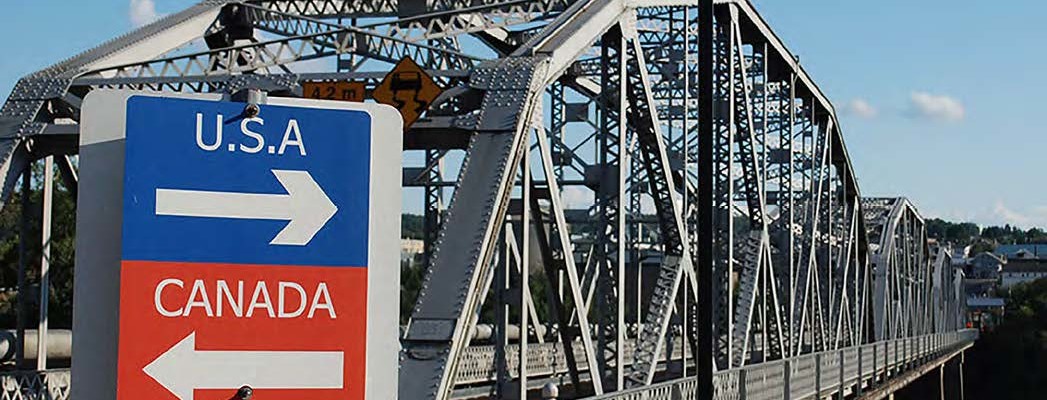The Atlantic Road Report
News and views collected from around the Atlantic region.
NEW BRUNSWICK
Tender awarded for construction of Edmundston-Madawaska International Bridge
The construction contract for the new Edmundston-Madawaska International Bridge project has been awarded to Reed & Reed Inc. of Woolwich, Maine. This bridge will replace the current structure that connects Edmundston and Madawaska.
The current bridge is 100 years old and approaching the end of its useful life. The bridge deck and superstructure are in poor condition and show signs of advanced deterioration. Since October 2017, the international bridge has had a five-ton weight limit, creating a detour.
“This international bridge is more than just a piece of infrastructure: it is an important link that brings communities and countries together,” said Transportation and Infrastructure Minister Jill Green. “This project will contribute to our priority of energizing the private sector by facilitating the movement of people and goods. This will allow our businesses to remain competitive while fostering economic growth in the region.”
The new bridge will be constructed on a new alignment. It will cross the Saint John River at about a 45-degree angle and will be located about 420 metres (1,400 ft.) upstream from the existing bridge. Because of this new alignment, the new structure will be nearly twice the length of the existing one. The new bridge will feature wider travel lanes and added shoulders on both sides. There will also be a raised sidewalk on the downstream side. The bridge will be constructed using steel girders supported on concrete substructures and is designed to last 100 years.
Maine’s Department of Transportation is leading this project and awarded the construction contract. They advertised the contract for bids on Dec. 23, 2020 and opened bids on Feb. 24. Three contractors had been pre-qualified to bid on the project and two submitted bids. One of the pre-qualified companies was from New Brunswick, but they did not submit a bid. The low bidder was Reed & Reed, with a bid of $86,532,251. This bid results in a total project cost increase of about $10.9 million more than previous estimates. Due to the size and complexity of this multi-year project, the governments of both Maine and New Brunswick have agreed to award the contract.
“The year-long challenges associated with the COVID-19 pandemic have laid bare the importance of the connections between Maine and Canada,” said Maine Department of Transportation Commissioner Bruce Van Note. “We are eager to move forward with this project to greatly improve one of these vital connection points. This new bridge will improve safety and support economic activities on both sides of the international border.”
In 2019, the project received a $36-million USD Infrastructure for Rebuilding America (INFRA) grant from the U.S. Federal Highway Administration. The U.S. Department of Transportation has authorized an additional amount of $15.7 million USD towards Maine’s Department of Transportation capital budget. This funding will be used to cover the cost overages on the international bridge project. The remaining costs are being shared by the Maine and New Brunswick departments of transportation.
Construction work is expected to begin in April. The opening of the new bridge to traffic is anticipated by the end of 2023. Demolition of the old bridge is scheduled to begin once traffic is moved onto the new bridge. The estimated final completion date of the project is June 30, 2025.
“Reed & Reed is pleased to be rebuilding this critical link between families, communities and nations,” said company CEO Jackson Parker. “We will be looking to hire locally as much as possible. We have a long history of building bridges for Maine’s Department of Transportation, beginning in 1928 with a $1,676 contract to replace a bridge in Hermon. We are excited to begin work on this project.”
NEWFOUNDLAND
Reopening of Atlantic Bubble Delayed
Protecting the health of Atlantic Canadians remains the overriding priority of Atlantic Premiers.
Premier Blaine Higgs of New Brunswick chaired a teleconference of the Council of Atlantic Premiers with Premier Iain Rankin of Nova Scotia, Premier Dennis King of Prince Edward Island and Premier Andrew Furey of Newfoundland and Labrador. They reviewed the state of the COVID-19 pandemic in the region and considered how to move forward on reducing travel restrictions within the Atlantic region.
Given the recent surge in cases of COVID-19 in parts of Atlantic Canada and the emergence of more transmissible forms of the virus, the Council of Atlantic Premiers has agreed to delay the reopening of the Atlantic Bubble by at least two weeks, to May 3rd, 2021.
The decision is based upon expert advice from the region’s Chief Medical Officers of Health.
Premiers will meet during the last week of April to review the status of outbreaks and determine if a further delay to May 10th, 2021 is required.
This delay will support a continued focus on addressing local outbreaks and the roll-out of vaccination programs across the region.
Premiers urge all Atlantic Canadians to adhere to public health measures designed to slow the spread of the COVID-19 virus.
When the Atlantic Bubble reopens, residents of the Atlantic provinces will be able to travel within the region without the requirement to self-isolate for 14 days.
All public health directives in each province must continue to be followed, including wearing a mask in public spaces, not traveling if experiencing any symptoms of COVID-19 and practicing physical distancing.
Premiers noted that the relaxation of travel restrictions will be closely monitored and may change at any time, based on public health advice regarding conditions within the region.
Premiers remain committed to working together to limit the spread of COVID-19, protect the health and safety of all Atlantic Canadians and strengthening the region’s economy while returning to community activities.
For more information about the COVID-19 response and specific public health requirements for each of the Atlantic Provinces, please consult the following links below:
- New Brunswick: http://www.gnb.ca/coronavirus
- Newfoundland and Labrador: https://www.gov.nl.ca/covid-19/
- Nova Scotia: https://novascotia.ca/coronavirus/
- Prince Edward Island: https://www.princeedwardisland.ca/en/topic/covid-19
NOVA SCOTIA
Nova Scotia capital budget over $1 billion for second consecutive year
For the second consecutive year Nova Scotia’s Liberal government has released a capital budget with over $1-billion in spending — a level the finance minister says will be sustained for years to come.
The $1.17 billion designated for highways, schools and hospitals is slightly larger than last year’s $1.042-billion plan, which had been the largest single-year capital plan in the province’s history.
Last year, former finance minister Karen Casey said the time was right to spend in areas of need because of the province’s strong financial position after five consecutive balanced budgets.
Current Finance Minister Labi Kousoulis told reporters March 23 that situation hasn’t changed, even though there is also a need for stimulus because of the effects of the COVID-19 pandemic on the economy.
“We’re going to be continuing with over $1 billion of capital investments in the future years as well,” said Kousoulis. “Generally the capital plan would have looked pretty much the same if we had not come into the pandemic.”
The minister said the increased capital spending is in part due to the speeding up of some projects in order to signal to the private sector that the government is confident the province will come out of the pandemic in strong economic shape.
Kousoulis said the province is able to carry out the increased spending because of its previous series of small surpluses, which improved the debt-to-GDP ratio. He said this happened at a time of low interest rates.
He added the province is in a much better fiscal position today than it was when the Liberals took power in 2013.
“We anticipate (interest) rates to be low in the coming years, and we are retiring debt from the ’90s,” he said.
The plan also includes $467 million for road, highway and bridge improvements that were previously announced.
There is no notable spending increase on government-subsidized housing, although there is some money to upgrade existing housing stock.
This report by The Canadian Press was first published March 23, 2021.
PRINCE EDWARD ISLAND
A Crapaud-area woman who came across a fake road barrier is warning drivers on the Trans-Canada Highway between Crapaud and New Haven to be on the lookout.
Susan MacVittie was on her way home to Crapaud from Charlottetown Tuesday night. Around 10 p.m., she was coming down the hill just west of Gass’s General Store.
“All of a sudden, in the dark, I came across what looked to be a roadblock that stretched across the Trans-Canada Highway on both sides of the highway,” said MacVittie.
There were pylons, wooden barriers and a sign that said Road Closed.
“So, you can imagine a car or vehicle is gaining speed, going down a hill – it was halfway down a hill. Luckily, I wasn’t going very fast,” said McVittie. “Then, an 18-wheeler came behind me and all I could think about was, ‘Uh-oh, if that 18-wheeler is gaining speed and suddenly has to put on his brakes, we’re going to get hit.”
MacVittie moved her car out of the way, to the shoulder on the other side of the road just as a second transport truck arrived. Then a car stopped from the other direction.
That’s when MacVittie called the RCMP. They didn’t know of any road closures but sent an officer and someone from the Department of Highways to check it out.
When she drove around the pylons and carried on, she didn’t come across any reason for the road to be closed.
“It was highway equipment,” she said. “Someone has stolen some equipment or something, is what I’m assuming.”
“All of a sudden, in the dark, I came across what looked to be a roadblock that stretched across the Trans-Canada Highway on both sides of the highway.”
On Friday morning, MacVittie saw a post on social media from another driver who had the same experience, this time in Crapaud, on Thursday around 11 p.m. The fake barrier was close to Englewood School.
“This is a very dangerous prank that someone is doing,” said MacVittie, noting the two incidents she knows of were in areas with low-visibility – on a turn and halfway down a hill.
“This is obviously a public nuisance, and it’s dangerous.”


